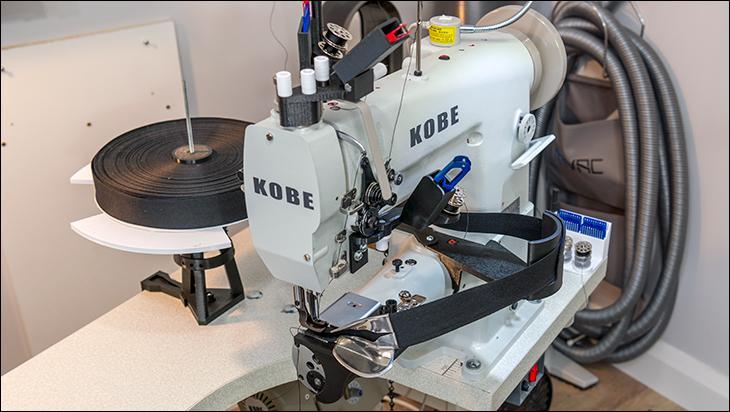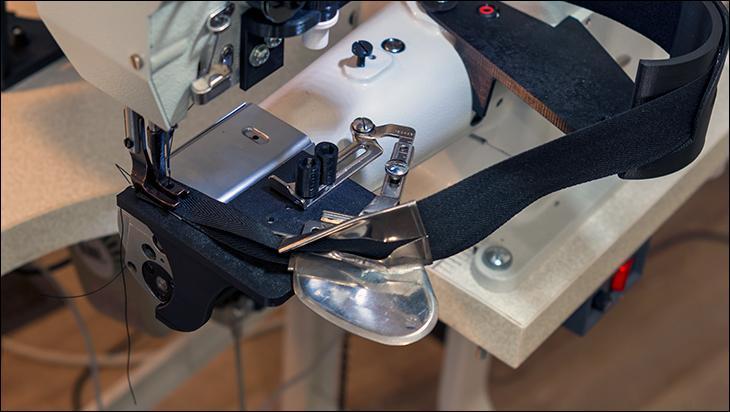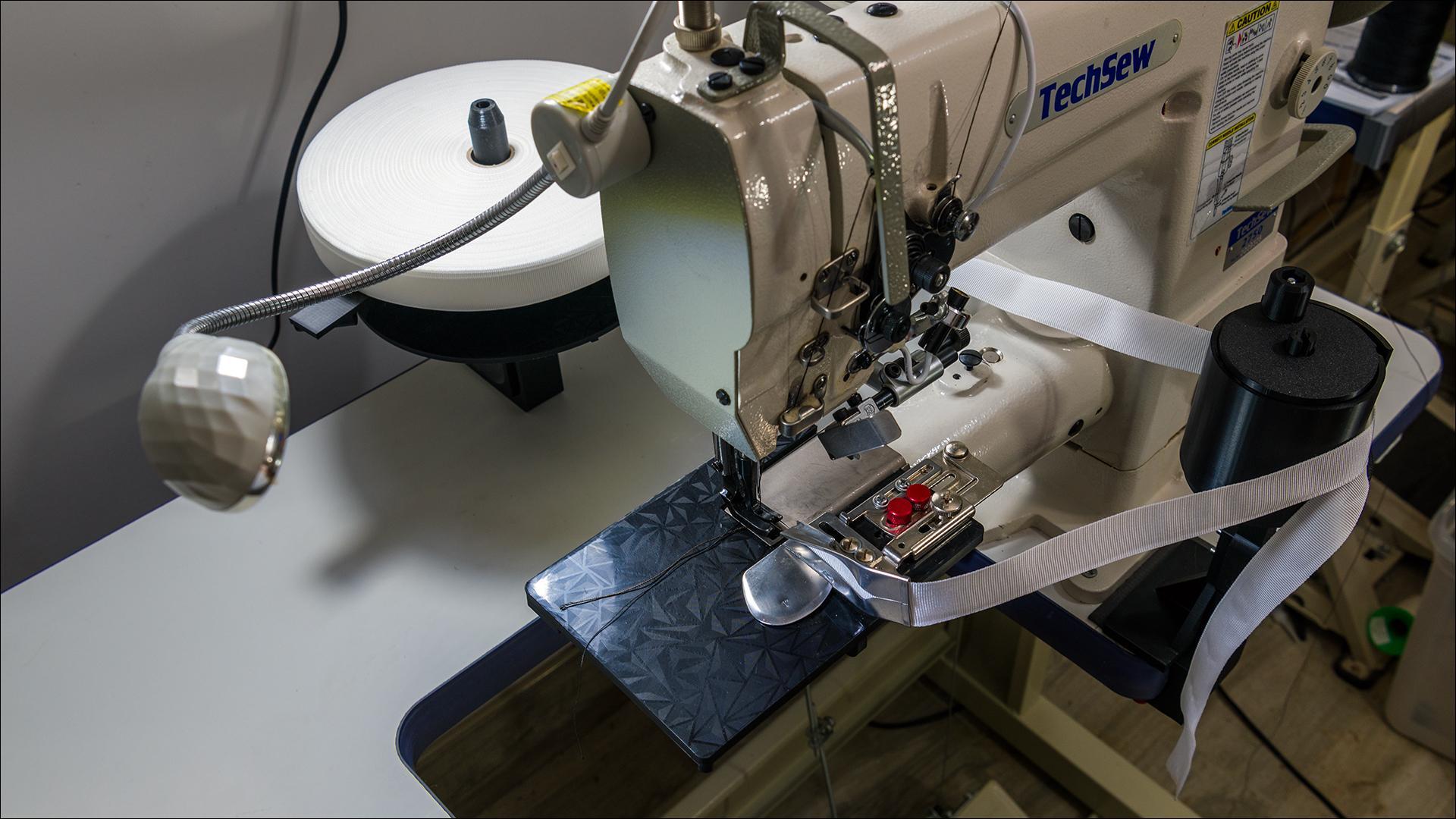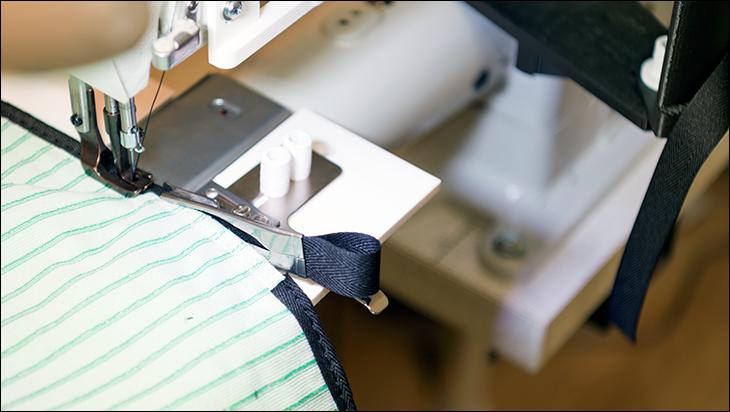
kgg
Contributing Member-
Posts
3,296 -
Joined
-
Last visited
Content Type
Profiles
Forums
Events
Blogs
Gallery
Everything posted by kgg
-
Just to add another twist to the conversion. If hardness of the burnish wheel is an important factor what would the drawback or pro's to using a metal burnishing wheel with machines grooves like the wooden ones??? Steel, Aluminum, Brass kgg
-
What is this "Man-Sew" device on a Singer machine????
kgg replied to Constabulary's topic in Leather Sewing Machines
It is an attachment for plinking. Here is a link outlining it. ( https://www.ebay.ca/itm/351741810267 ) kgg -
What size and type of thread are you using?? How thick of leather are you trying on sewing??? What size of needle are you using??? kgg
-
The .8mm thread size is roughly equal to V554 thread so there is really only the Juki TSC -441 and clones along with the one armed bandits that can come close to that thread size. As a comparison V138 thread is about .4mm. If thread size is a main factor the machines you highlighted will not work. kgg
-
I am not sure but that thread I think is just polyester not bonded so it may give you some problems related to like lint buildup. I would recommend: i) Purchase the 1lb spools of whatever thread you decide to purchase it will give you less spring back / coiling problems then the smaller 8 / 4 / 2 ounce sizes. ii) Purchasing two 1lb spools that way you can have one spool for winding bobbins as you sew and the other one for the top thread. That way you don't need to un-thread the machine just to wind a bobbin. Some like what I done with my Juki DNU-1541S. iii) Use bonded polyester or bonded nylon thread from a brand name manufacturer rather then the cheap Chinese stuff. kgg
-
When I clicked on the link you supplied it appears as the correct needle for a system 135x16 needle for a size 110 needle. The size 110 is for V69 (40 metric) thread. What size of needle did you order for what size of thread you are planning on using? Also what is the thickness of leather you are planning on sewing? kgg
-
Here is a screen shot of the spec for the Juki DNU-1541 series: My understanding is the system 135x8 is not designed for walking foot machines made for drop feed machines. It is a slightly shorter needle which may require you to adjust the needle bar as well the hook to the needle timing. Needle selection reference: The Thread Exchange by Juki model ( https://www.thethreadexchange.com/miva/merchant.mvc?Screen=CTGY&Category_Code=needle-systems-juki ) The equivalent to a system 135 needle for leather, 135x16, is the DPx16 and 135x1 NRTW. The equivalent to a system 135 needle for fabric, 135x17, is the MR, 3355 MR, DPx1 MR, DPx17 Why not use the correct system needles recommended by the manufacturer, needles are cheap and save yourself the problems / headaches associated with other then recommended needles. kgg
-
No, do NOT use a system 134 needle for the Juki DNU -1541 and Juki DNU-1541S they are made and setup for a system 135 x 17 x (needle size) for fabric or 135 x 16 x (needle size) for leather, check you manual. Here is a good reference chart for needle size vs thread size. ( https://www.tolindsewmach.com/thread-chart.html ). I would also suggest: i) reducing the presser foot pressure as it appears the pressure foot is imprinting the leather needle plate hole into the leather. ii) increase the bobbin tension using the drop method of setting the bobbin tension. kgg
-
Adler 169-373 vs Minerva 72317 101 vs Juki LS 1341
kgg replied to lehmanjack945's topic in Leather Sewing Machines
I will PM you. -
Adler 169-373 vs Minerva 72317 101 vs Juki LS 1341
kgg replied to lehmanjack945's topic in Leather Sewing Machines
Photo 1: i) Tells me it was used in a factory setting with little or no maintenance, the timing belt is cracked and is on it's last legs. The machine needs to be properly flushed out to remove any debris so it can be determined what else needs or potentially needs to be replaced. ii) missing presser foot lifting mechanism iii) missing base gasket and cylinder arm oil drain cotton cord Photo 2: i) Tells me someone replaced the main tension assembly and possibly the bobbin winder. ii) Top thread guide pin missing Photo 3: Shows a lot of discoloration / wear on the nose. Photo 4: i) Missing chrome cover plate on the front of the head that covers the lifting mechanism. ii) In the background of the fourth photo I did notice a second Juki LS-1341 on a dolly. My bad mind tells me this is a fresh off the boat from an overseas factory setting and shipped in. Did you ask where the machine came from? Personally I don't recommend buying an ex factory machine. EX factory machines are gotten rid of for a reason unless you are prepared to do any possible repairs yourself and the price is dirt cheap. I would suggest you keep looking buying a good used machine from a hobbyist or buy a new clone from a reputable dealer. Some others maybe better able to suggest a dealer close to you but you have not included your location. kgg -
I do use V138 in my Juki DU-1181N and have it for thinner stuff as my Juki DNU-1541S hates thinner stuff. A thing to remember is how Juki rates their machines. Thread wise they rate their machines on what that model of machine can handle in both the needle and in the bobbin at the max rated sewing thickness NOT what the max size of thread can be stuffed through the max rated needle size it can handle in the needle bar. The Juki DU-1181N is rated for V92 thread and can handle a #23 needle which is rated for V138 thread. Some clones might be temped to rate the machine for V138. You are right a compound feed should be better. kgg
-
My take: In a flatbed the 3/8" thickness generally is under ideal conditions. If you are at or close I think you need to move to a cylinder arm machine with a flatbed attachment in the Class 341 / 1341 machines. You are probably going to find that using V46 thread could be a chore as the needles typically for system 135 x 16 for that size of thread are thin and will have a tendency to bend / break. I would suggest probably consider using V69 as a bottom end thread size in thin stuff. This style of servo motor is becoming popular but choose one with at least 9 internal coils. The more internal coils the better the starting speed and torque characteristics. With the brushless servo motors this feature is usually included. You can try it and decide if you like that feature. Some like it others not so much. In my opinion this is a poor twice removed cousin of a Juki DNU-1541S. I recently had a Consew 206RB-5 that was intended to replace my walking foot Juki DU-1181N. I kept the Juki DU-1181N and got rid of the Consew 206RB-5. The older ones were made in Japan and the new ones ?????? There a lot of decent flatbed Juki DNU-1541S clones available just like there are a lot of cylinder arm Juki LS-341 clones. If possible take a sample of your stuff and test drive some machines to see what best fits your needs, budget and choose a vendor with a good after sales reputation. Buy Once, Cry Once kgg
-
help from the masters..... Is the machine fixable?
kgg replied to MattiJoy2's topic in Leather Sewing Machines
I agree and it also depends on the ability / experience of the person doing the repair. kgg -
If you are pleased with the Juki DDL 8300 for light items and your Consew 206. Are you planning on replacing the Consew 206 as the Juki DNU-1541S is a far superior machine then the Consew 206? I also should say my Juki DNU-1541S does not like thinner items and can have a tendency to suck those items down into the needle plate/ feed dog that is why I have a Juki DU-1181N for thinner items. kgg
-
help from the masters..... Is the machine fixable?
kgg replied to MattiJoy2's topic in Leather Sewing Machines
My take without seeing any photo's: With a crack that severe there are three questions that need to be answered. 1) Does it move freely and sew? If not it there are more then likely internal damaged / misaligned parts. 2) What parts are damaged / misaligned / bend inside. Parts for Durkopp Adler in general can be expensive and depending on the age of the machine they maybe difficult to get. 3) Welding can be done on cast iron but and it is a big but can the machine be welded properly so nothing internally warps. If the crack could be repaired it does beg the question why hasn't the repair shop had it done? Personally I would consider this a parts machine so it's worth is next to nothing except to someone with the same or similar model. As for the repair shop well I would would be very wary and probably consider finding another repair shop. Since you are looking at cylinder arm machine I have two suggestions: 1) Set a realistic budget. My rule of thumb if I'm looking for a used machine for myself I am willing to pay 60% to 70 % of the cost a new machine if it is owned by a hobbyist. 2) Determine the class of machine that covers 90% of what you plan on sewing. As a quick reference: i) The Juki DNU-1541S and clones for Flatbed needs. ii) The Juki LS-1341 and clones for Cylinder Arm needs. These machines in general cover most needs. If it is going to be your main machine I would suggest a cylinder arm machine with a flatbed attachment and probably go with a new machine. Clone machines and there are many are a cost effective way. kgg -
You need to let us know a couple of things. Which country / state / province you are located? The Juki DNU-1541S is a great machine but it may not be the best one for your sewing needs. What are you planning on sewing with what size of thread? kgg
-
Binding with a right angle binder on a walking foot machine
kgg replied to Dave9111's topic in Leather Sewing Machines
Half decent equipment can make all the difference. kgg -
Two very different machines. i) Both are flatbed clone machines more then likely made in China. ii) The Weaver 303 is similar to the Juki 1181N (made in China) a walking foot machine and max's out at V92 thread. iii) The Cobra Class 20 is similar to the Juki 1541S (made in Japan) a compound walking foot and max's out at V207 thread. This type of work is better done on a cylinder arm machine. Remember that you can add a flatbed attachment to a cylinder arm machine to do work best done on a flatbed but you can't change a flatbed into a cylinder arm machine. You may want to consider a Juki LS-1341 or clone machine with a flatbed attachment rather then a flatbed machine. What is the size of thread you are wanting to sew with and in what thickness of leather? kgg
-
Binding with a right angle binder on a walking foot machine
kgg replied to Dave9111's topic in Leather Sewing Machines
That is a very early mini table top attachment on a Kobe LS-1341 which in reality is a Juki LS-341 clone like the Techsew 2750. I have various setups of small table top attachments. Depends on what I am binding on which machine and how much tape I need. Photo 1 shows a platter, tape guide and a micro binder nose attachment on a Kobe LS-1341 Photo 2 shows is a better view of the micro binder nose attachment Photo 3 shows a mini table top attachment on Techsew 2750 Pro with a multi purpose tape guide / tape dispenser / tape tensioner. Photo 4 shows a mini table top attachment on Class 441 clone that has width guides on the table top and a multi purpose tape guide / tape dispenser / tape tensioner. If it is flatwork the flatbed machines are a better choice most times. I was probably just lazy and didn't want to setup a flatbed machine to do one item. kgg -
If it is "genuine" leather like / similar to the one in the following topic save the buckle and have someone make one out of real leather. kgg
-
My take: i) Both machines are older, look well used and probably used in a commercial environment. ii) Both machines are compound feed machines where the feed dog/needle/presser foot move the material along. iii) If I'm not mistaken the Consew is a clone of the Juki 563 made in Japan. iv) PFAFF replacement parts / accessories are typically expensive with some being more difficult to get. v) PFAFF is a brand name machine. vi) Both machines have a clutch motors which for most inexperienced users has a very high / hard sewing control learning curve. A replacement motor, servo motor, that would give you the sewing control needed will cost approximately $200. vii) By the time you get either the PFAFF or the Consew in a usable controllable sewing condition you would be up to approximately $1100 barring no needed repairs. viii) The cost of a new Consew 206RB-5 which I think are now made in China will cost about $1450 plus maybe shipping costs. I have owned both PFAFF and Consew machines over the years and was never pleased with either brand. The last one being a Consew 206RB-5 with the intention of replacing a plain jane Juki 1181N walking foot. Kept the Juki 1181N. You did mention wanting to do purses which I think would be better / easier done on a cylinder arm machine like a Juki 1341 or clone rather the flatbed machines you are looking at so you may eventually wind up getting a cylinder arm. Personally I would not consider either for a number of reasons but particularly for the age, condition and price being asked. Just my thoughts, kgg
-
Belt cutting machines always slightly narrower than "belt width"?
kgg replied to nstarleather's topic in How Do I Do That?
Have to checked with a caliper the spacers to see if they are actually flat, with no wear, the spacers measure out to 1" long and the two smaller ones are .25" and when combine give you 1.5"? A quick check would be to use a piece of 1 1/2" Al edge trim from you local hardware store and see if it will properly between the blades. kgg -
Binding with a right angle binder on a walking foot machine
kgg replied to Dave9111's topic in Leather Sewing Machines
I wouldn't comment on the 90 degree binder as I generally don't use them but I do have a couple suggestions when using the inline binders. i) get a proper platter that the coil of binding tape would sit on so the tape is not being dragged on the table top. ii) set the binding tape platter up so: a) the platter is off the table top and can spin freely. b) the tape is coming off the platter pretty close too but not rubbing the inside edge of the machine. Which also means you will probably have to install a tape guide between the platter and the binder that can give adjustable back tension. c) the platter and the binding tape needs to be high enough off the table top so the binding tape enters the binder at the right height and angle. iii) The front edge where the tape exits can be slightly widened or closed with a pair pliers to add tension or make adjust for thinner or thicker binding tape. This can also be done on the end that the binding tape enters the binder. iv) When finishing a run and you are overlapping the binding tape where you started from cut you binding tape and tuck it into the binder. That way you get a nice finished edge rather then a raw edge finish. kgg -
Yes but it requires you to turn the item as per a poor mans reverse. No, a lot of lockstitch machines never had a reverse level think of the old Singers. From your photo it appears to never had a reverse lever. No. kgg
-
Keep in mind they are still in the 60 to 70 lb range which can over time cause the table to sag if not supported. kgg






